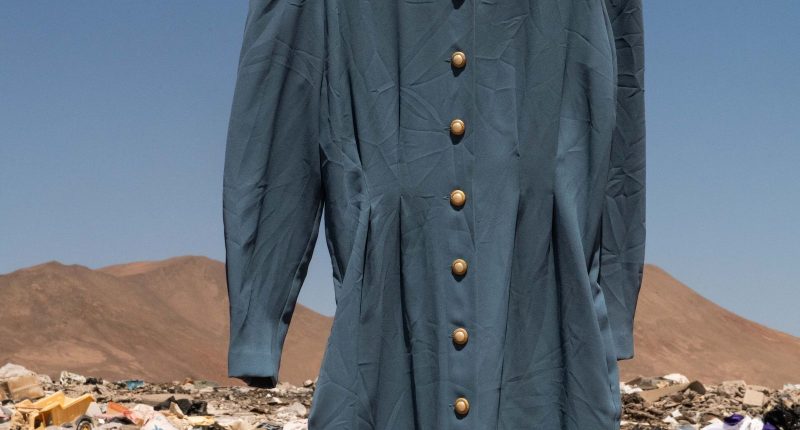What Needs to Happen to Tackle Fashion’s Climate Impact – On Sept. 17, on the heels of New York Fashion Week, Climate Week saw more than 70,000 people marched in the streetsof Manhattan demanding the end of fossil fuel industries and climate justice at scale. This was in stark contrast to the shows on the runway, where collections were presented without the slightest acknowledgement of the increasing signs of our ongoing climate emergency— some as recent as a week before Fashion Week began, with the floods in Libya killing thousands of people and displacing hundreds of thousands.
Despite Fashion Week’s dreadful silence regarding one of today’s most pressing existential issues, shows, including luxury fashion brand Coach, were interrupted by climate protests and signs calling for the end of animal exploitation (also implicated in greenhouse gas emissions). This resulted in protestors being violently snatched by men in black and kicked out of venues.
Is fashion a reflection of a larger denial of and apathy towards the reality of the climate crisis, or is the industry, as fashion critic Cathy Horyn writes in The Cut, “halted into a paralysis?”
The consensus seems to be that fashion executives aren’t visibly addressing the climate crisis. When speaking with creative directors, designers, and fashion industry professionals, there seems to be a shared fear amongst them: A fear of “getting canceled” for not doing the right thing—or for not doing enough when it comes to addressing climate issues. But visibly or not, the question remains: Are they anxious enough about the scientific consensus that in less than six years, without a massive reduction in carbon emissions, our world will begin to tip into a chain of ecosystem collapse?
As a climate activist, I have worked since the early aughts to provide access to crucial information regarding climate justice in the fashion industry and beyond through my organization Slow Factory. Through our work, we have observed that there is an undeniable collective anxiety that seems to exist only on the surface of the fashion industry. And while the fashion industry is filled with promises and good intentions, with a few exceptions, the overall trajectory of fashion is one of business as usual.
On the one hand, lack of transparency and lack of clear data remain an issue. But more fundamentally there seems to be a lack of perspective in the fashion industry as a whole: stakeholders operate in narrow tunnel vision goal-oriented frameworks that aren’t broad enough to perceive the entire system in question. The industry is made up of complex decentralized systems that have a plethora of human rights issues and environmental impacts particularly around chemical dyes and textile waste. Businesses, however, have a hard time making decisions that would impact the overall system because they don’t have a clear overview of it. Instead, decisions are made with laser-focused precision on certain parts of the industry, but limited impact to the whole. Currently, bridging the gap between intention and action relies on adjacent non-profits and institutions such as Fashion for Good, the Sustainable Apparel Coalition (SAC), and the Apparel Impact Institute—all three of which are not collaborating closely enough to problem solve and have competing agendas. The proposed Fashion Sustainability and Social Accountability Act (also known as the Fashion Act) also makes many promises to reduce emissions, but that depends not only on brands and their C-Suite’s endorsement. It also relies on a plethora of other actors (producers, manufacturers, marketers, and other executive decision makers) that need to work together towards shared goals and establish clear milestones.
How can the fashion industry, known for its fierce competitiveness, reach a collective agreement, share knowledge and data, and have enough incentive to collaborate in order to reduce carbon emissions? Especially when the general reaction on social media tends to lean into despair and doubt that these harmful systems of overproduction and exploitation of human labor can’t be transformed at scale in time.
Like any good relationship, we need to start communicating. The fashion industry is large, complex, and touches on so many global systems—from agriculture, animal husbandry, metals, and mining to global transportation, supply chains, pulp and paper, manufacturing, plastics and fossil fuels, retail and consumer goods—that it creates a microcosm of the entire global economy. Some of these industries are working in tandem with each other—and some are not aware that they must be. Companies and even departments continue to operate in silos, and although the issues and solutions are systemic, brands seldom meet to discuss shared climate goals unless they are on stage at conferences, making promises to appease their customer base with often dubious follow-through.
Ignorance, then, becomes a sinister bliss, and downplaying sustainability seems to be the norm in fashion—as though the elephant in the room was not big enough, loud enough, interrupting pristine fashion shows enough. But in this vast system of complexity where the long-term negative effects will be felt by all (and the offenders are only concerned with short-term profit), who will be shouldering and fronting the financial commitment required to fund systemic change? And better yet, how can we measure impact within the fashion industry when most of the data points aren’t traceable and can’t seem to agree on sustainable standards?
A 2018 report co-authored by Fashion for Good and Apparel Impact Institute estimates that the systemic change within the fashion industry required to address the climate emergency will cost $1 trillion. This will require the biggest offenders and players in the industry to collaborate and invest in solutions.

Used clothes discarded in the Atacama desert, in Alto Hospicio, Iquique, Chile, 2022.
Mauricio Bustamante—Visum/Redux
Solutions are starting to get underway. Measuring impact and decarbonization solutions that move beyond clean tech and towards processes within the industry has recently inspired multiple players to raise funds to support necessary innovation in the industry. This includes replacing fossil fuel-based ones such as polyester, acrylic with new materials such as fiber derived from recycled plastic bottles. There are also initiatives and frameworks in fashion embracing a total carbon reduction across the supply chain, such as the UNFCCC Fashion Industry Charter for Climate Action, and the Fashion Pact launched in 2019 as a mission given to Kering Chairman and CEO, François-Henri Pinault by French President, Emmanuel Macron, with dozens of global fashion signatories.
But overall the industry is far away from meeting any science-based emissions targets, so further efforts are necessary. The Fashion Act, for instance, would require fashion companies to be responsible for their entire supply chains. Slow Factory has also developed its own context-specific framework called the Sustainable Standard, which would force fashion brands to consider the emissions and human rights effects of their operations and their waste, reusing their deadstock materials including unwanted and unsold goods.
So far, a few funds have emerged focusing on financing climate-informed solutions in the fashion industry. For example, the Slow Factory Fund for Systemic Change is now raising 0.01% of these required funds—$100 million—to invest in socially responsible climate justice solutions. It is the only fund unifying goals of emissions reduction, human rights, and waste circularity. Apparel Impact Institute’s $250 million Fashion Climate Fund aims for incremental change across the fashion supply chain to reduce emissions. Both of these funds are examples of initiatives that represent clear investments in a shared future, leveraging philanthropic and venture funding sources to accelerate climate innovation.
If fashion executives care and can act fast enough to invest in solutions, we can achieve true traceability, work across departments, measure impact, and reflect the times the industry exists in.









